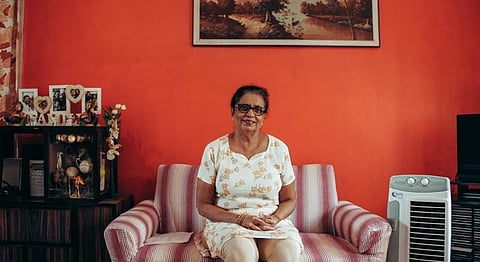
- HOMEGROWN WORLD
- #HGCREATORS
- #HGEXPLORE
- #HGVOICES
- #HGSHOP
- CAREERS
- ABOUT US
- CONTACT US

The stink of garbage from her compost bins that are lined with worms doesn’t faze Maria D’Souza. She opens the lid of a bin to show the rotting garbage that has been collected from her building and the resulting compost that will be used later for the garden. “A passerby once complained about the smell. the stink dissipates after five minutes but imagine somebody living with this garbage 24/7 for an entire year. We can’t deal with our own garbage for five minutes but can happily dump it on someone else. Do you think it is fair?” she asks.
D’Souza is one of the most active members of her area ALM no. 33 (Advance Locality Management) in H (West) Ward that consists of Bandra, Khar and Santacruz. All 44 societies under her ALM have 100 percent waste segregation with 12 producing zero waste today. 65-year-old D’Souza began her efforts to clean up her area way back in 1998 when she was employed as a teacher in St. Stanislaus School in Bandra. “I started by giving social service lectures to my students and got them involved. We painted our school walls with environmental messages, wrote letters to local corporators and organised street plays in Bandra,” she reminisced.
Since 2013, D’Souza has not let as much as 500 kilograms per month of garbage go to waste. “My building alone creates 10 kg of wet waste every month,” she explains. “We send the dry recyclable waste to the BMC clean-up trucks twice a week. We segregate our waste in four ways that is wet, dry, e-waste and medical waste. I do not remember the last time we had to buy compost for our building,” she said. She also explains that to get the message across, she had to stand at the spot where the truck picked up garbage and sent back every dustbin that was not properly segregated. “Children understand but their parents don’t. A student of mine once asked his parents to segregate waste and they told him, let Maria do it in her own house. In a city that generates 10,000 tonnes of garbage everyday and with all these fires that keep erupting, how is it not our problem?” she asked.
Apart from residential societies, D’souza has also roped in gardens, two schools, two churches and two retreat houses for waste management. “It began with waste segregation awareness in 2000. My students have been helping me with everything since then. They helped me put together reports and created our stall at a BMC waste management exhibition,” she said.
Now retired and working as a freelance teacher, D’Souza also overlooks the whatsapp group of over 80 members from the area. “We discuss all our issues there and I also send every member emails. Only when necessary do I rarely take print-outs,” she said. But all is not peachy when people don’t want to get involved. “When it comes to waste, people are apathetic. They just don’t want to attend meetings. As long as it is out of their sight, it is out of their mind. BMC spends Rs. 140 crore everyday just to transport waste from one corner to the other. If we managed our own waste, that money could be utilised for better use. Imagine, we could get solar panels installed or rain water harvested. People don’t realise that it is their tax that is getting used to transport waste. ALM 44 in Chapel road went defunct because nobody took it up after the children handling it graduated from school. It is sad that out of around 100 ALMs only 50 are active,” she said.
In the H (West) ward of BMC, Jr. Overseer of solid waste management, Mr. Prakash Gohil has some anecdotes to share as well. “Earlier, composting was not being done a large scale in Maria m’ams area but in the last two years it has caught speed. All our awareness programs, presentations and meetings are gathering good traction. If every ALM followed Maria mams footsteps, BMC would be free from the crushing burden. When people don’t sort their waste, we spend even more time segregating it. Sometimes, dry and wet waste, both, end up at the dumpyard which can’t take any more capacity. Many of the dump yards in the city are full and if we even think of sending it anywhere else, we are met with resistance. Even if we do find a land to dump our waste outside of Mumbai, the transport bill is going to be huge. When an ALM doesn’t need our truck, we can phase it out and it eases the burden on the dumpyard. We had 23 trucks trucks out of which we phased out two because ALM no.4 is also doing well. We had to re-introduce a truck because the slums near the airport were generating too much waste. the waste was attracting large birds which was obstructing the flights taking off. Slum dwellers haven’t been educated in waste management so the truck goes specially in that area,” he said.
D’Souza has definitely blazed the trail for people to follow. All the city needs is people who raise a stink when the need arises.
You can read more about her here.
